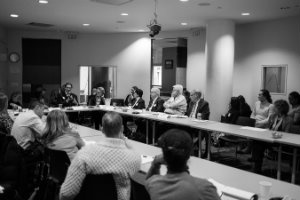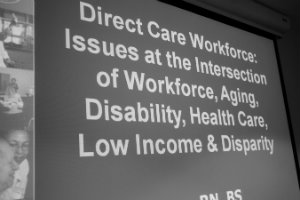 Steven Dawson of PHI addresses the briefing on direct care workers held recently by Philanthropy New York.
Steven Dawson of PHI addresses the briefing on direct care workers held recently by Philanthropy New York.The health of any given community is fragile and complex. It is greater than the sum of individual health outcomes or access to care. The health of a community rests upon an infrastructure that meets the changing demands and needs of its people within constrained resources. Increasingly, our infrastructure needs to address employment, economic stability, and rising health care costs.
This is especially true given the sea change occurring, with 10,000 people turning age 65 each day in the United States. The maturing of the boomers is fundamentally shifting our view of what a healthy community looks like.
We at the John A. Hartford Foundation recognize that the direct care workforce is central to the health of communities and the health of older adults. For those unfamiliar with the direct care workforce, you may know them as nurse’s aides, home health aides, or paraprofessionals. They help millions of older Americans and those living with disabilities remain in the community, avoiding costlier and unwanted institutional care.
Direct care workers are also the backbone of nursing homes and hospitals, providing much needed assistance with bathing, feeding, repositioning of the bedbound, and other activities of daily living. Direct care workers are critically important to the provision of health care for our most frail, ill, and vulnerable.
 Earlier this month, Philanthropy New York hosted a member briefing on the direct care workforce sponsored by the Hartford Foundation, the F.B. Heron Foundation and the Ford Foundation. I was privileged to lead the session, and the panelists included Steven Dawson, senior strategic advisor and former president of PHI; Carla Washington, executive director of the Direct Care Alliance; Paula Span, author of the New York Times’ New Old Age blog; and Clara Miller, executive director of the F. B. Heron Foundation. The packed room included a number of direct care funders, including representatives from the Fan Fox and Leslie R. Samuels Foundation, Altman Foundation, New York Community Trust, New York State Health Foundation, Stavros Niarchos Foundation, United Hospital Fund, and The Atlantic Philanthropies.
Earlier this month, Philanthropy New York hosted a member briefing on the direct care workforce sponsored by the Hartford Foundation, the F.B. Heron Foundation and the Ford Foundation. I was privileged to lead the session, and the panelists included Steven Dawson, senior strategic advisor and former president of PHI; Carla Washington, executive director of the Direct Care Alliance; Paula Span, author of the New York Times’ New Old Age blog; and Clara Miller, executive director of the F. B. Heron Foundation. The packed room included a number of direct care funders, including representatives from the Fan Fox and Leslie R. Samuels Foundation, Altman Foundation, New York Community Trust, New York State Health Foundation, Stavros Niarchos Foundation, United Hospital Fund, and The Atlantic Philanthropies.
Span vividly described shadowing Marilyn Daniel, a home health aide in Washington, D.C., for a 2009 article featured in the Washington Post. While Daniel provided excellent care, Span noticed that her eyeglasses were damaged. The aide told her the glasses were broken by a patient and she could not afford to have them fixed. She had no health insurance and struggled with her own chronic illness. Deeply committed to her patients, Daniel barely eked out a living for her family.
Sadly, the direct care workforce is often invisible to planners and policymakers, despite the compelling stories and data about aides such as Marilyn Daniel. According to Dawson, there are more than 4 million direct care workers in the United States. There are more direct care workers today than doctors, nurses, or school teachers. They represent one of the largest segments of the workforce in the U.S. and this is the job category with the highest projected growth. PHI is a leading national organization addressing the needs of the direct care workforce, advocating for better jobs and better care while serving as a living laboratory for redesign as a New York City-based agency.
Perhaps the lack of attention is because this workforce is comprised primarily of women (89%), mothers supporting families. They are the working poor. In New York City, for example, one-in- seven low income workers is a home care worker. They often lack benefits such as paid sick leave. Their wages are subsistence. Just last year, they finally gained minimum wage and overtime protections from the U.S. Department of Labor that go into effect Jan. 1, 2015.
Carla Washington believes that direct care workers need to become a stronger national voice for change, and her organization is working to support that voice.
If we can address the quality of direct care worker jobs, we will strengthen our communities. The challenges are daunting. Will we have sufficient numbers of direct care workers to meet the needs of our aging society? Will we provide a livable wage or will women and families become more impoverished and disperate? What will happen if we can’t meet the projected employment needs? Will we be forced to rely on higher-cost and unwanted institutional care? What are the opportunities?
Are there ways in which we, as funders, can invest in the direct care workforce that may simultaneously support the health of communities and their most vulnerable residents?
Can we, for example, build on recommendations from the Institute of Medicine and the advocacy of the Eldercare Workforce Alliance (to which both PHI and the Direct Care Alliance belong) to expand the scope of the work and raise the quality of the jobs and the care?
We all need to be the change we want to see. To that end, the Hartford Foundation, a longtime funder of PHI, joined with the F.B. Heron Foundation in support of a philanthropic equity campaign. Miller described philanthropic equity as one more tool in the funder’s toolbox. It is a way to strategically scale up PHI’s successful efforts. The funding collaborative aims to achieve a $9 million goal to double PHI’s mission impact by improving the jobs of more than 200,000 direct-care workers per year—thereby improving care annually for at least 400,000 low-income elders and people living with disabilities nationwide.
We believe strongly that improving the quality of the direct care workforce is an essential step in improving the quality of health care for older adults. This open collaborative is one important way we, as funders, can come together to address the challenging issues surrounding the direct care workforce.
